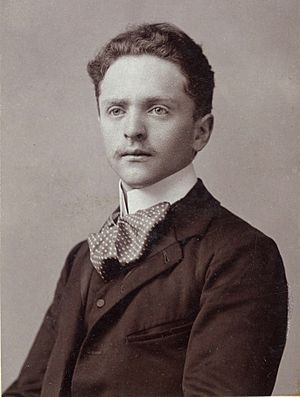Béla Balázs facts for kids
Quick facts for kids
Béla Balázs
|
|
|---|---|

Béla Balázs c. 1910s
|
|
| Born |
Herbert Béla Bauer
August 4, 1884 |
| Died | May 17, 1949 (aged 64) Jósefváros, Budapest, Second Hungarian Republic
|
| Nationality | Hungarian |
| Occupation | Film theorist, film critic, screenwriter |
| Movement | Formalist film theory |
| Awards | Kossuth Prize (1949) |
Béla Balázs (born Herbert Béla Bauer on August 4, 1884, in Szeged, Hungary) was a famous Hungarian writer, poet, and film expert. He was very important in understanding how movies work and what makes them art. He passed away on May 17, 1949, in Budapest.
Contents
Béla Balázs's Early Life and Career
Béla Balázs was born to Simon Bauer and Eugénia Léwy. He started using his pen name, Béla Balázs, in newspaper articles before he moved to Budapest in 1902. In Budapest, he studied Hungarian and German languages. His brother, Ervin Bauer, became a well-known biologist.
Balázs was a key person in a group called the Sonntagskreis, or Sunday Circle. He started this intellectual discussion group in 1915 with friends like Lajos Fülep and György Lukács. They met at his home on Sunday afternoons to talk about ideas.
Working with Famous Composers
Béla Balázs is perhaps best known for writing the story for the opera Bluebeard's Castle. He first wrote it for his roommate, Zoltán Kodály. Kodály then introduced him to the composer who would write the music, Béla Bartók.
This teamwork continued when Balázs wrote the story for the ballet The Wooden Prince. Both of these works became very famous.
Life in Exile and Return
After a time of political change in Hungary in 1919, Béla Balázs lived outside of Hungary for many years. He lived in Vienna and Germany, and from 1933 until 1945, he lived in the Soviet Union.
In 1922, Balázs published a book of fairy tales called Mantel der Träume. This book was later translated into English as The Cloak of Dreams: Chinese Fairy Tales. The famous writer Thomas Mann praised it as a "beautiful book."
While in Vienna, he wrote many reviews about films. His first book about movies, Der sichtbare Mensch (The Visible Man), came out in 1924. This book helped create the idea that film is a language of its own. His ideas influenced other important film directors like Sergei Eisenstein.
Balázs also worked as a popular consultant and wrote screenplays for movies. He wrote the script for G. W. Pabst's film Die Dreigroschenoper in 1931. He also helped direct the film Das blaue Licht (1932).
One of his most famous films is Somewhere in Europe (also known as It Happened in Europe), which was released in 1947. He co-wrote this film, which was directed by Géza von Radványi.
Later Years and Legacy
In his final years, Béla Balázs received more and more recognition, especially in German-speaking countries. In 1949, he was given the Kossuth Prize, which is the highest award in Hungary.
Also in 1949, he finished his important book, Theory of the Film. This book was published after his death in 1952. In 1958, the Béla Balázs Prize was created in his honor. This award recognizes great achievements in cinematography, which is the art of making films.
Selected Films Béla Balázs Worked On
Here are some of the films Béla Balázs was involved with:
- Modern Marriages (1924)
- Madame Wants No Children (1926)
- One Plus One Equals Three (1927)
- The Girl with the Five Zeros (1927)
- Grand Hotel (1927)
- Doña Juana (1927)
- Sunday of Life (1931)
See also
 In Spanish: Béla Balázs para niños
In Spanish: Béla Balázs para niños
- Ballets by Béla Balázs
- Film semiotics

